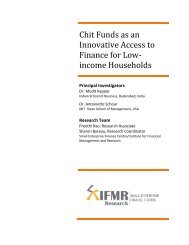Government of India Volume I: Analysis and Recommendations
Government of India Volume I: Analysis and Recommendations
Government of India Volume I: Analysis and Recommendations
Create successful ePaper yourself
Turn your PDF publications into a flip-book with our unique Google optimized e-Paper software.
5. A new Financial Redressal Agency (FRA) will be created.<br />
6. A new Debt Management Office will be created.<br />
EXECUTIVE SUMMARY<br />
7. The existing FSDC will continue to exist, though with modified functions <strong>and</strong> a statutory<br />
framework.<br />
The functions <strong>of</strong> each <strong>of</strong> these seven proposed agencies are as follows:<br />
Reserve Bank <strong>of</strong> <strong>India</strong> It is proposed that RBI will perform three functions: monetary policy, regulation<br />
<strong>and</strong> supervision <strong>of</strong> banking in enforcing the proposed consumer protection law <strong>and</strong> the proposed<br />
micro-prudential law, <strong>and</strong> regulation <strong>and</strong> supervision <strong>of</strong> payment systems in enforcing these two<br />
laws.<br />
Unified Financial Agency The unified financial regulatory agency would implement the consumer<br />
protection law <strong>and</strong> micro-prudential law for all financial firms other than banking <strong>and</strong> payments.<br />
This would yield benefits in terms <strong>of</strong> economies <strong>of</strong> scope <strong>and</strong> scale in the financial system; it<br />
would reduce the identification <strong>of</strong> the regulatory agency with one sector; it would help address<br />
the difficulties <strong>of</strong> finding the appropriate talent in <strong>Government</strong> agencies.<br />
This proposed unified financial regulatory agency would also take over the work on organised<br />
financial trading from RBI in the areas connected with the Bond-Currency-Derivatives Nexus, <strong>and</strong><br />
from FMC for commodity futures, thus giving a unification <strong>of</strong> all organised financial trading including<br />
equities, government bonds, currencies, commodity futures <strong>and</strong> corporate bonds.<br />
The unification <strong>of</strong> regulation <strong>and</strong> supervision <strong>of</strong> financial firms such as mutual funds, insurance<br />
companies, <strong>and</strong> a diverse array <strong>of</strong> firms which are not banks or payment providers, would yield<br />
consistent treatment in consumer protection <strong>and</strong> micro-prudential regulation across all <strong>of</strong> them.<br />
Financial Sector Appellate Tribunal The present SAT will be subsumed in FSAT, which will hear appeals<br />
against RBI for its regulatory functions, the unified financial agency, decisions <strong>of</strong> the FRA<br />
<strong>and</strong> some elements <strong>of</strong> the work <strong>of</strong> the resolution corporation.<br />
Resolution Corporation The present DICGC will be subsumed into the Resolution Corporation which<br />
will work across the financial system.<br />
Financial Redressal Agency The FRA is a new agency which will have to be created in implementing<br />
this financial regulatory architecture. It will setup a nationwide machinery to become a one stop<br />
shop where consumers can carry complaints against all financial firms.<br />
Public Debt Management Agency An independent debt management <strong>of</strong>fice is envisioned.<br />
Financial Stability <strong>and</strong> Development Council Finally, the existing FSDC will become a statutory agency,<br />
<strong>and</strong> have modified functions in the fields <strong>of</strong> systemic risk <strong>and</strong> development.<br />
The Commission believes that this proposed financial regulatory architecture is a<br />
modest step away from present practice, embeds important improvements, <strong>and</strong> will<br />
serve <strong>India</strong> well in coming years.<br />
Over a horizon <strong>of</strong> five to ten years after the proposed laws come into effect, it would<br />
advocate a fresh look at these questions, with two possible solutions. One possibility is<br />
the construction <strong>of</strong> a single unified financial regulatory agency, which would combine<br />
all the activities <strong>of</strong> the proposed Unified Financial Authority <strong>and</strong> also the work on payments<br />
<strong>and</strong> banking. Another possibility is to shift to a two-agency structure, with one Consumer<br />
Protection Agency which enforces the proposed consumer protection law across<br />
the entire financial system <strong>and</strong> a second Prudential Regulation Agency which enforces<br />
the micro-prudential regulation law across the entire financial system. In either <strong>of</strong> these<br />
paths, RBI would then concentrate on monetary policy.<br />
These changes in the financial regulatory architecture would be relatively conveniently<br />
achieved, given the strategy <strong>of</strong> emphasising separability between laws which define<br />
functions, <strong>and</strong> the agencies that would enforce the laws. Over the years, based on a<br />
pragmatic assessment <strong>of</strong> what works <strong>and</strong> what does not work, the <strong>Government</strong> <strong>and</strong> Parliament<br />
can evolve the financial regulatory architecture so as to achieve the best possible<br />
enforcement <strong>of</strong> a stable set <strong>of</strong> laws.<br />
xxvi FINANCIAL SECTOR LEGISLATIVE REFORMS COMMISSION



